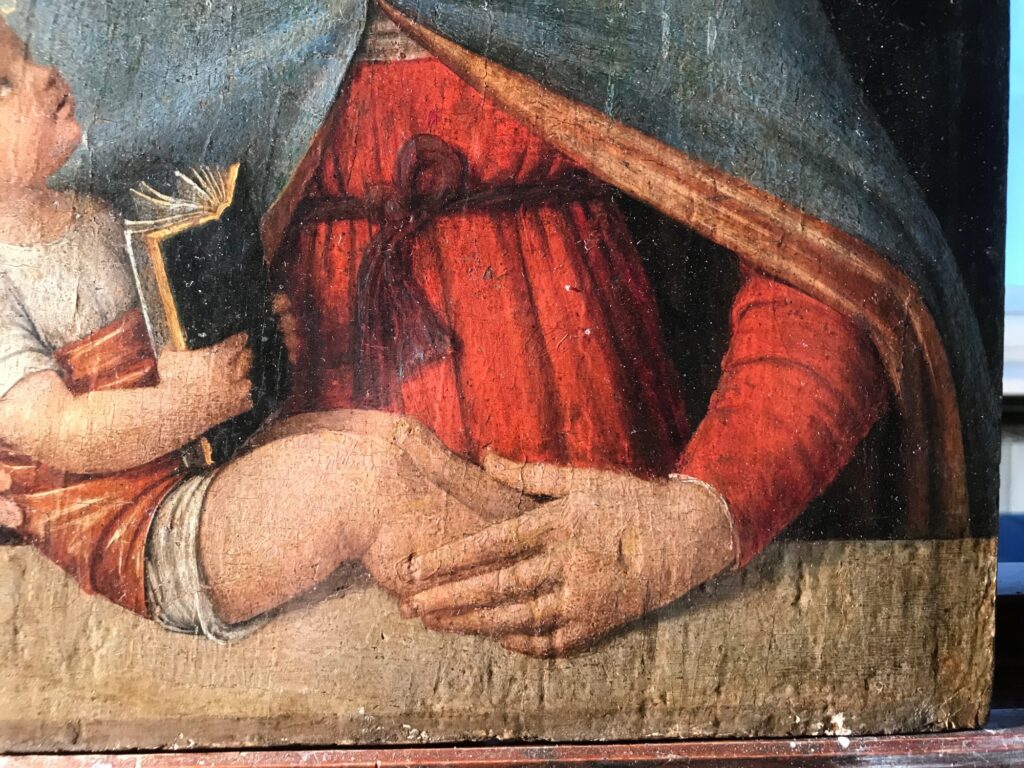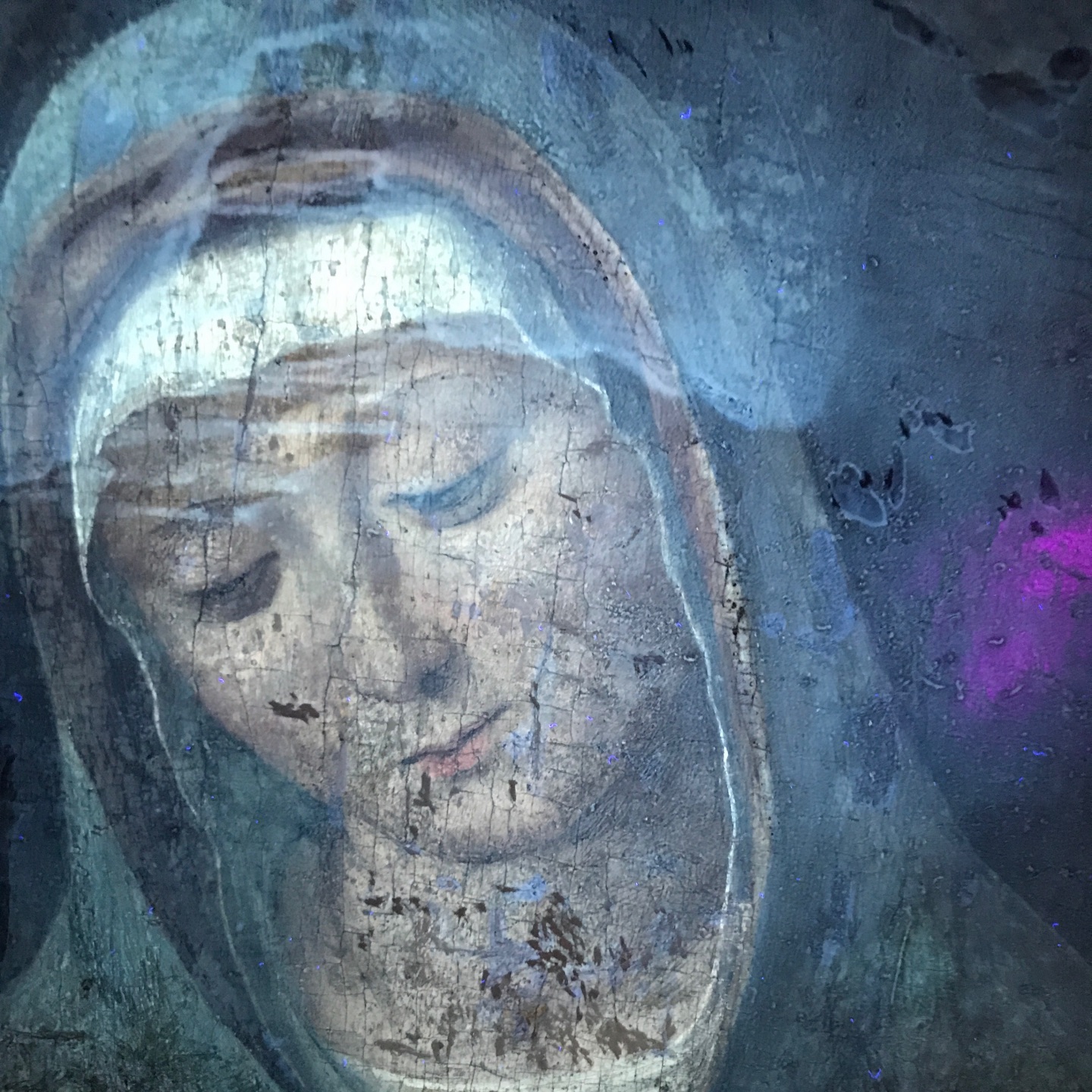The restoration of a board painting is always a complex intervention as it has to deal with different conservation issues: those involving the support, the pictorial layer, the gilding and even the frame. Having already intervened on other paintings by Andrea Solario and thus knowing his modus operandi, this was a particularly welcome assignment for me because it gave me the opportunity to continue to learn more about his painting technique.
The painting, heavily burdened with darkened varnish, also had numerous altered retouches and extensive repainting that largely covered parts of the background and base.
A UV photographic documentation made it possible to assess before the cleaning intervention the exact consistency of the old pictorial retouches concentrated mainly in the form of small brush strokes on the blue coat and the flesh tones, while more extensive repainting was present on the background and base of the painting.
Observing the work under grazing light also made clear depressions in the color that corresponded to galleries of woodworms present immediately under the pictorial film that, no longer having support had precipitated inside the support.
It can be assumed, considering the alteration and type of this old intervention, that the work underwent restoration around the 1950s-60s.
To the same restoration intervention can be traced that of the Florentine-style parchettatura visible today on the back of the panel.
Florentine-style parchettatura was a highly invasive intervention very common in the last century and was practiced to give and maintain flatness to board paintings that naturally curved being painted only on the front.
Before reinforcing the painting with the parchettatura, the board was subjected to thinning in order to offer less resistance in the flattening phase. Once flatness was achieved on the back, a wooden grid was placed whose vertical elements were glued and the horizontal ones sliding to accommodate the natural movements of the wooden fibers.
In the case of this painting, the horizontal elements of the parquetry were no longer flowing and posed a great danger to the integrity of the work.
Indeed, when a wooden support cannot expand and shrink naturally, it splits with cracks that also affect the paint film.

Andrea Solario, Madonna con Bambino leggente, immagine alla lampada di Wood che evidenzia i ritocchi eseguiti negli interventi passati (macchie grigie e puntini neri)
The restoration work on Solario painting was conducted on two different levels: one dealing with the support and one with the pictorial layer.
After securing the color by means of a veiling of rice paper glued with carboxylcellulose, the horizontal elements of the parchettatura were progressively removed and thinned to restore smoothness.
Given the fragility of the substrate caused by the action of xylophagous insects, it was deemed appropriate to perform consolidating infiltrations into the wood.

Andrea Solario, Madonna con Bambino leggente, foto a luce radente che evidenzia le depressioni della pellicola pittorica nelle gallerie dei tarli
After removing the glazing and performing some punctual consolidations of the paint film, solubility tests were conducted with solvent mixtures of different polarity performed on very small areas to identify the appropriate type of solvents to be used for the removal of non-original paint and altered retouches dating back to previous restoration work.
In view of the extreme thinness of the pictorial film, in part slightly abraded by careless cleaning, it was preferred to thicken the chosen solvent in a gel in order to achieve a more controlled and superficial cleaning. The methodology employed followed criteria of gradualness in thinning the superfetations, always acting with microscope control.By removing the darkened surface varnish and old altered retouches, the delicate original coloring, the splendid blue of the mantle, the refined iridescence of the ribbon belt and the gold trim returned to light.

Andrea Solario, Madonna with Reading Child, the painting completed after cleaning before the pictorial retouching intervention
After cleaning, stuccoes overflowing the actual gap emerged, as well as filler stuccoes of paint film depressions at the woodworm tunnels that covered original color.
The fillers, once swelled with demineralized water, were removed by scalpel and, where strictly necessary, reintegrated with stucco of the same composition as the preparation.
Pictorial reinstatement of the gaps and abrasions was conducted with stable pigments used to “spike” the abrasions and complete the actual gaps to allow a good reading of this fine painting.
A light veil of low specific weight varnish applied by misting was applied with the function of protecting the painting from atmospheric pollution and thermo-hygrometric changes.
The intervention on the frame consisted of cleaning to remove dust deposits, consolidation of fragile and detached parts, and reintegration of some gaps.





